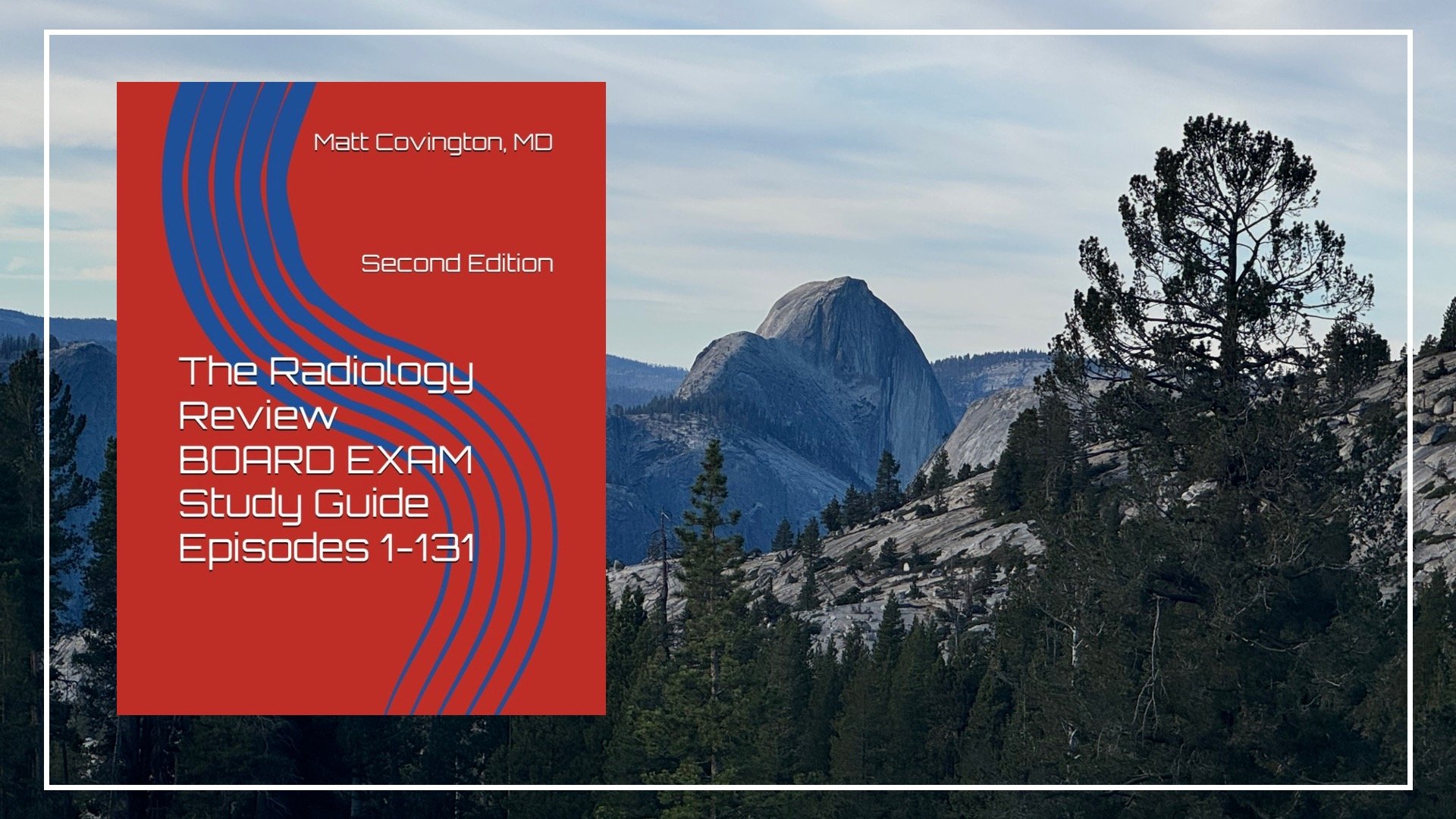Gallbladder and Biliary Tree Part 1
Part 1 review of the gallbladder and biliary tree for radiology board exams. Download the free study guide on this episode by clicking here.
Show Notes/Study Guide
Note that these episodes do not include discussion of nuclear medicine hepatobiliary scintigraphy as I have already covered that in a two-episode podcast series on HIDA scans. I also will not go into detail on liver masses such as cholangiocarcinoma as I’ve already discussed these in a two-episode series on liver masses. Please refer to those episodes and associated study guides to access my review of those topics. This episode highlights other features of biliary diseases and presents other important knowledge points of the biliary system for radiology board exams.
What are approximate values of normal gallbladder wall thickness and gallbladder long-axis length?
For board exams, remember that normal gallbladder wall thickness is less than 3 mm and normal long-axis gallbladder length is less than 10 cm. These values should help steer you in the right direction on board exams. For clinical practice, follow your institutional guidelines for accepted cutoff values.
True or false? The proximal common bile duct runs posterior to the portal vein and right hepatic artery.
False. The proximal common bile duct runs anterior to the portal vein and right hepatic artery. Variant anatomy does exit wherein the hepatic artery runs anterior to the common bile duct. Note that a so-called Mickey Mouse view on ultrasound exists which includes the proximal common bile duct comprising Mickey’s right ear, the proper hepatic artery left to the common bile duct comprises Mickey’s left ear, and the portal vein as Mickey’s face.
What are classic ultrasound features of gallstones?
Gallstones on ultrasound classically appear as shadowing echogenic structures in the dependent gallbladder lumen that are mobile. Note that the normal empty gallbladder lumen is anechoic.
What are classic ultrasound features of acute cholecystitis?
Classic ultrasound features of acute cholecystitis include gallstones, gallbladder wall thickening, gallbladder enlargement/distention, pericholecystic fluid, sometimes an impacted stone in the gallbladder neck, and a positive sonographic Murphy’s sign.
True or false? Extensive gallbladder wall thickening is more commonly the result of a systemic process causing gallbladder wall edema rather than cholecystitis.
True. Cholecystitis often is associated with mild to moderate gallbladder wall thickening. Extensive gallbladder wall thickening more commonly results form a systemic edema-causing process rather than cholecystitis.
What are classic non-biliary causes of gallbladder wall thickening?
Non-biliary causes of gallbladder wall thickening include portal hypertension, cirrhosis, hypoproteinemia, congestive heart failure, pancreatitis, hepatitis, and lymphatic obstruction
What are classic biliary causes of gallbladder wall thickening?
Classic biliary causes of gallbladder wall thickening include cholecystitis, adenomyomatosis, sclerosing cholangitis, AIDS cholangiopathy, and malignancy.
What is the wall echo shadow sign of the gallbladder on ultrasound?
The wall echo shadow sign is commonly tested on board exams and describes the ultrasound appearance of a gallbladder that is filled by shadowing gallstones. The key features of the wall echo shadow sign are in the superficial most aspect a hypoechoic line representing the hypoechoic gallbladder wall, overlying a bright echogenic band representing the surface of the gallstones, with underlying diffuse shadowing from the gallstones.
What is the term for a gallbladder that has a diffusely calcified wall?
A porcelain gallbladder has a diffusely calcified wall. Note that there is historical concern for porcelain gallbladder and potential though questioned increased cancer risk such that prophylactic cholecystectomy is sometimes considered.
What are key differences between gangrenous cholecystitis and emphysematous cholecystitis?
With gangrenous cholecystitis the gallbladder wall and mucosa are dead and sloughing of membranes into the gallbladder lumen may be evident and is a key imaging finding. Both gangrenous and emphysematous cholecystitis may show air within the gallbladder wall. However, with emphysematous cholecystitis the gallbladder wall and mucosa are viable and in-tact and sloughing of membranes into the gallbladder lumen will not be seen.
On contrast-enhanced CT or MRI, gangrenous cholecystitis classically shows non-enhancement of the gallbladder wall and often shows hyperenhancement of the adjacent liver parenchyma due to transmural gallbladder inflammation. Note that a sonographic Murphy sign is not obligatory in the setting of gangrenous cholecystitis and may be absent in certain cases.
True or false? Cholelithiasis increases the risk of emphysematous cholecystitis.
False. Emphysematous cholecystitis is typically not related to gallstones but is more common in diabetic patients. This results from infection of the gallbladder with gas-forming bacteria which can include types of E. coli and Clostridium welchii. Prognosis can be poor, and mortality can approach something like 20% due to gangrene. A transhepatic percutaneous cholecystostomy tube may be desired for treatment, with the transhepatic route chosen to reduce the risk of biliary peritonitis.
What are key differences in the ultrasound shadowing pattern with emphysematous cholecystitis, porcelain gallbladder, and a wall echo shadow sign from a gallbladder that is filled with shadowing stones?
Emphysematous cholecystitis: dirty shadowing
Porcelain gallbladder: variable shadowing
Wall echo shadow sign: clean shadowing
What is the classic clinical history for a patient with acalculous cholecystitis?
Acalculous cholecystitis tends to occur in debilitated patients so think of this when a question stem asks about cholecystitis in the setting of a debilitated ICU patient or other similar scenario. Also note that treatment of acalculous cholecystitis is often non-surgical with a percutaneous cholecystostomy tube.





